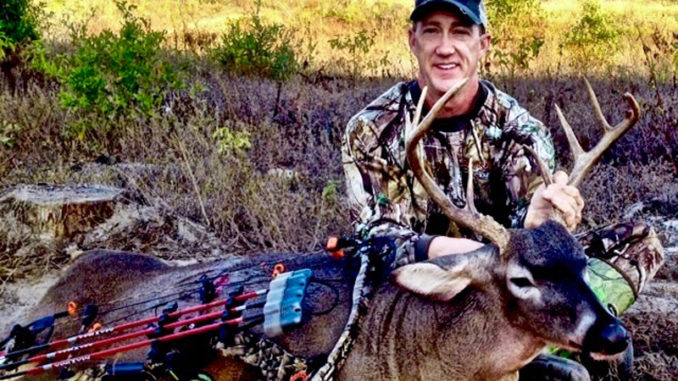
The midpoint of the season is approaching, so it might be time to change up your game plan, make any necessary adjustments and then head into the woods to pull out the second-half win.
In sports, it’s better to be ahead than behind at halftime. But it’s what you do with halftime adjustments and what you’re able to accomplish in the second half of the game that usually determines whether you win or not.
It’s the same way in deer hunting — especially when big bucks are your goal.
Curtis Simpson of West Monroe is well known for his deer hunting success, but what a lot of people don’t know is that he often uses the first half of the season to set up the second. Curtis is a bowhunter, but whether you use arrows, primitive weapons or guns, the same principles apply.
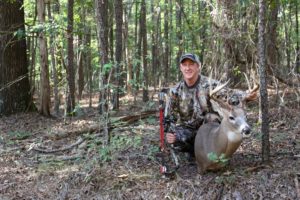
“December has been good to me as a deer hunter, but it is because I use all my preparation and all my patience to help make it that way,” he said. “A lot of times guys will see big bucks on their trail cams or in the woods and crash in there on them. That’s a huge mistake.
“The odds are in your favor the second half, but you can’t shoot yourself in the foot during the first half by letting them know you are there. If you do that, those big deer probably won’t come out except at night.”
Do not disturb deer
That’s a common complaint these days: Deer are becoming more nocturnal. But Simpson said if you’re quiet, calm and don’t disturb the big deer in the first half — you are a lot more likely to get a good shot in December or January.
One reason they become nocturnal is because they feel threatened all the time.
“Deer usually get into the first rut the week of Thanksgiving and in the weeks following, so that’s when the odds turn in your favor as the big bucks let their guard down some,” he said. So you have to study big deer and figure out their weaknesses, just like football coaches do with their opponents.
And properly using trail cameras is an excellent way to do that.
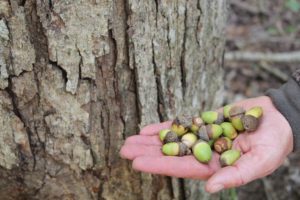
Simply seeing a big buck on a deer cam won’t help you kill it, but Simpson said if you can determine a pattern, that’s key. Use trail cams to help you position yourself as close to the bedding area as possible with spooking a big deer.
If your cams are showing nice deer at 11 p.m. or 2 a.m., you are too far from where they are bedding. When you see them right at dusk or daylight, you know you have caught one close to where it’s laying up.
But if you get too close and let it know you’ve been there — you can forget it. One thing that you hear about deer hunting that is 100 percent true is that the older they get, the wiser they get.
In fact, one time Simpson had been seeing a big deer on his camera, but noticed the buck didn’t show back up in the woods or on his camera for two or three days after he hunted.
Simpson later realized that when he parked his truck, even though he was a half-mile away, his lights were shining across a clear-cut into the deer’s bedding spot. The buck simply refused to come out for days when it knew something was going on.
“Let me tell you, the big bucks will pattern you way before you can pattern them,” he said. “That’s how they became big bucks.”
Top trail camera tips
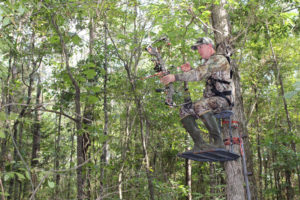
Other camera tips Simpson suggested include putting out cameras with gloves on, placing them 30 to 36 inches high and always being quiet. Never crash into a deer’s bedding area to put up a camera. And never cross the trail you think it’s traveling to put up a camera or check it. Always study your deer cam photos carefully to determine the direction deer are moving.
Simpson said there is one thing that overrules cameras in the second half — a fresh scrape or rub. If you find an active scrape, hunt it. You’ll never see all the deer on a trail cam, but if there’s a hot scrape, there’s a buck coming by regularly.
It’s also all about the food in the second half of the season.
Simpson said deer are a little more spooky around food piles than they are natural browse, but stuff like corn and rice bran attracts does.
And during the rut, if you see a doe come to a feeder or food plot while nervously looking over its shoulder, there’s probably a big buck close by.
If acorns are still plentiful — especially white oak acorns — and you can find a good spot close to a bedding area nearby, that’s also a good spot to find big deer.
Besides the rut, there is one other thing that will get a big buck up on its feet — a cold front.
If you can hunt right before, during or the morning after a cold front, you are more likely to see deer moving. And the more you see deer moving, the more likely you’ll see big ones move.
Simpson offered one final tip for the remainder of the season.
“You know how coaches always hold out a special play or two for the second half in case they need it?” he said. “Same with deer hunting: I’ve mentioned it before, but if you know you are on a big buck, but he is not showing himself, don’t go in there looking for him. Learn as much as you can about him. Wait on him to come to you.
“And remember the odds are better in your favor if you wait until the second half. You’ve got to, as they say in football, ‘Play the whole 60 minutes.’”
Gearing up for the second half
Curtis Simpson has a clear offensive and defensive game plan for winning the second half of deer hunting. On defense, that includes a ‘common scents’ approach to keep his foe off balance. On offense, it means scoring points using his ‘best players.’
Here’s how he does it:
Common ‘scents’ on defense
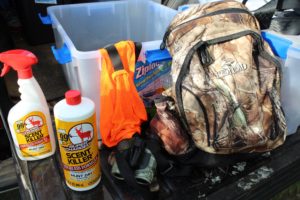
They say defense wins championships in football — and Simpson believes the same thing in trophy deer hunting.
His defense consists of a well-organized ScentLok lineup that takes away much of big buck’s home field advantage. Most of his shots are under 35 yards, so to get deer that close, he has to defend from them sensing his presence.
“I keep all my ScentLok gear in airtight Rubbermaid storage boxes, and I keep them in the back of my truck,” he said. “I’ve got a locking cover and I never take them out. I keep my clothes in one, my rubber and insulated boots in one, my backpack in one and extra gear in another. I never get dressed in my ScentLok clothes until I get to the woods. I have a heavy rubber door mat that I throw on the ground to stand on while getting dressed.”
He always goes out of his way to block his scent, but it’s even more important in the second half of the season when the deer are more on edge after seeing and hearing hunters in the woods.
“I keep my backpack and everything I take to the woods in a container, so they are never exposed to anything, anywhere, except the woods,” he said. “I use Wildlife Research Center Super Charged Scent Killer Spray on everything as added protection.”
Dependable players anchor the offense
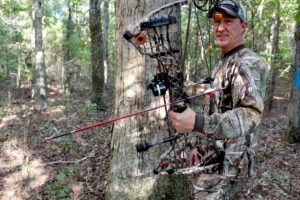
With the defense working, Simpson turns to the offensive attack using his hunting MVP — a Mathews Heli-m bow that he has shot for more than 10 years.
He uses an Optimizer Ultra One-Pin Sight and a QAD Ultra arrow rest. His objective, obviously, is to score — hopefully with heavy racks featuring eight, 10 or even 12 points.
One thing in most archery hunters’ playbook is a wrist strap, but Simpson put his on the bench years ago.
“The wrist strap was mostly to keep the bow from jumping out of your hand, but the modern bows are so smooth that shouldn’t happen now,” he said. “Frankly, it’s the best thing I ever did. Not having a wrist strap makes it so much easier to get your bow ready and hang it back up.
“That little bit of extra movement could give you away if a big one is eyeing you out of the thicket.”
He uses a loop on his bowstring and a Scott Archery S-Horn release. It’s simple and easy to get on and off the loop without having to look, he says.
His ammo is a Maxima Red Carbon Express arrows with Rage Chisel Tip blades. The arrows are forgiving at different draw weights, and the broadhead has a devastating point for quick kills.
Patience is a virtue for deer hunters
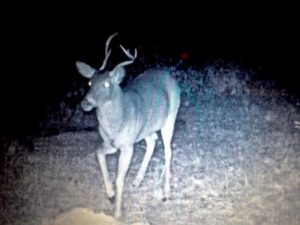
Studying — but staying away from big deer until the second half of the season — has led to two of the biggest deer Curtis Simpson has ever killed.
One of his best trophies is a nearly 5-year-old 10-point killed in 2015. He saw the deer for the first time in 2012, but it didn’t look like much. He saw the buck regularly on camera the next year when it was 3 ½ years old.
But the deer (Photo 1) had a terrible looking rack and a right front leg injury, possibly from being hit by a vehicle. So Simpson let the deer pass.
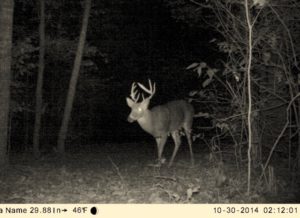
In 2014, the deer showed back up as a decent 8-point (Photo 2), but again, Simpson stayed patient and didn’t venture into the buck’s territory.
The next year, his patient plan paid off.
The deer had grown to a full big-bodied 10-point, (Photo 3) and Simpson got him.
Trail cameras also helped Simpson kill a big 8-point last season. He studied the deer via trail cam for weeks and found that in mid-December, the buck was coming out about 10 in the morning. And every afternoon, it returned about 4 or 4:30 in the evening.
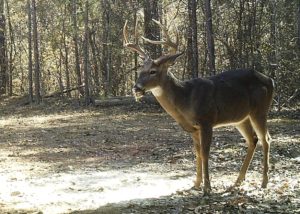
So Simpson quietly set up his lock-on climbing stand one evening near the feed pile about 2 p.m. and waited. About 4, a doe came out and was constantly looking over its shoulder.
About 15 minutes later, it was obvious from trail cam photos why: The big buck stepped out and headed its way. Two minutes later, Simpson shot the big buck, now a trophy 8-point.
When he took the card out of his cameras that night, Simpson saw the big deer standing there at 10 a.m. the very morning he killed it — just like the scouting report said it would.


